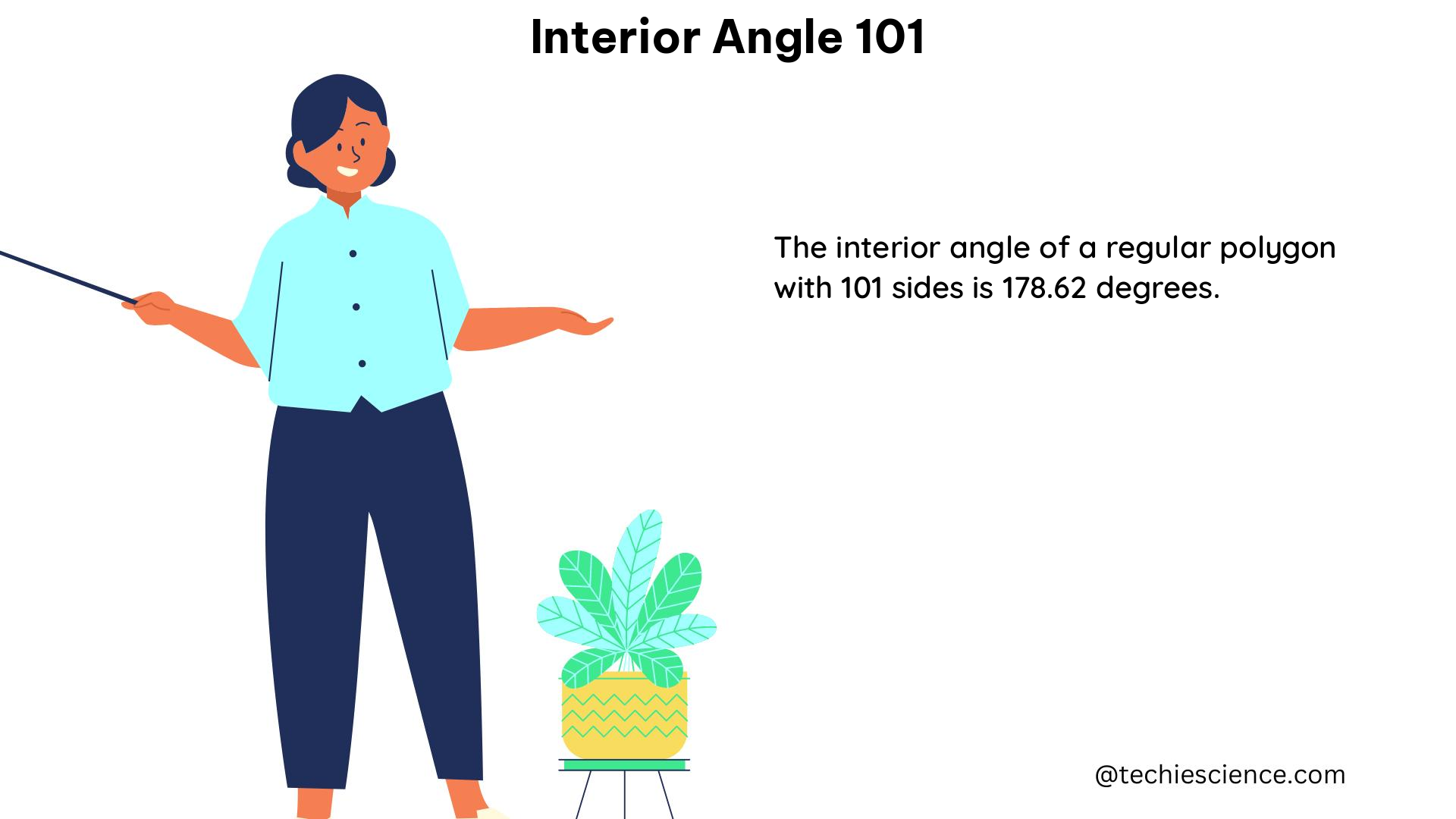The measurement of an interior angle of a regular polygon can be calculated using the formula (n-2) * 180°, where n is the number of sides of the polygon. This formula can also be used to calculate the sum of the interior angles of an irregular polygon, making it a crucial concept for science students to understand.
Understanding the Basics of Interior Angles
An interior angle of a polygon is the angle formed between two adjacent sides of the polygon, measured on the inside of the shape. In a regular polygon, all interior angles are equal, while in an irregular polygon, the interior angles can vary.
The formula for calculating the measurement of an interior angle of a regular polygon is:
(n-2) * 180° / n
Where n is the number of sides of the polygon.
For example, a regular decagon (10 sides) has interior angles of:
(10-2) * 180° / 10 = 144°
Calculating the Sum of Interior Angles

The sum of the interior angles of any polygon, regular or irregular, can be calculated using the formula:
(n-2) * 180°
Where n is the number of sides of the polygon.
For example, a quadrilateral (4 sides) has a sum of interior angles of:
(4-2) * 180° = 360°
This formula can be used to find the measure of a missing interior angle in an irregular polygon by subtracting the sum of the known angles from the total.
Exterior Angles and Supplementary Angles
The exterior angles of a polygon are the angles formed between the sides of the polygon and a line tangent to the polygon at that point. The sum of the exterior angles of any polygon is always 360°.
Furthermore, the exterior angle and interior angle at each vertex of a regular polygon are supplementary, meaning they add up to 180°. This relationship can be used to calculate the measure of the exterior angles of a regular polygon.
For example, in a regular decagon, the exterior angle would be:
360° / 10 = 36°
Technical Specifications
The technical specifications for calculating the measurement of an interior angle of a regular polygon include the formula:
(n-2) * 180° / n
Where n is the number of sides of the polygon.
This formula can also be used to calculate the sum of the interior angles of an irregular polygon by adding up the measures of all but one of the interior angles and subtracting the sum from (n-2) * 180°, where n is the number of sides of the polygon.
DIY (Do It Yourself) Examples
-
Regular Hexagon: To calculate the interior angle of a regular hexagon (n=6), use the formula:
(6-2) * 180° / 6 = 120° -
Irregular Pentagon: If the measures of four of the interior angles of an irregular pentagon (n=5) are known to be 70°, 80°, 90°, and 100°, the measure of the missing angle can be found by subtracting the sum of these four angles (340°) from
(5-2) * 180° = 540°, resulting in a missing angle of 200°.
Theorem and Formulas
- Interior Angle Theorem: The measure of an interior angle of a regular polygon is given by the formula
(n-2) * 180° / n, wherenis the number of sides of the polygon. - Sum of Interior Angles Theorem: The sum of the interior angles of any polygon with
nsides is given by the formula(n-2) * 180°. - Exterior Angle Theorem: The measure of an exterior angle of a regular polygon is given by the formula
360° / n, wherenis the number of sides of the polygon. - Supplementary Angles Theorem: The exterior angle and interior angle at each vertex of a regular polygon are supplementary, meaning they add up to 180°.
Examples and Applications
- Regular Polygon Example: A regular octagon (8 sides) has interior angles of
(8-2) * 180° / 8 = 135°. - Irregular Polygon Example: An irregular heptagon (7 sides) has a sum of interior angles of
(7-2) * 180° = 900°. - Exterior Angle Example: A regular dodecagon (12 sides) has exterior angles of
360° / 12 = 30°. - Supplementary Angles Example: In a regular pentagon (5 sides), the interior angle is
(5-2) * 180° / 5 = 108°, and the corresponding exterior angle is360° / 5 = 72°, which are supplementary angles.
Numerical Problems
- Calculate the interior angle of a regular polygon with 15 sides.
- Find the sum of the interior angles of an irregular polygon with 9 sides.
- Determine the exterior angle of a regular polygon with 20 sides.
- If the sum of four interior angles of an irregular hexagon (6 sides) is 440°, find the measure of the missing angle.
Conclusion
Interior angles are a fundamental concept in geometry and are crucial for understanding the properties of polygons. By mastering the formulas and theorems related to interior angles, science students can effectively solve a wide range of problems and deepen their understanding of the geometric principles that underpin many scientific disciplines.
References
- Interior Angles Of A Polygon- GCSE Maths – Steps & Examples, Third Space Learning, https://thirdspacelearning.com/gcse-maths/geometry-and-measure/interior-angles/
- Angles in a Polygon | Measurement, Formula & Examples, Study.com, https://study.com/learn/lesson/angles-in-polygons-sum-measure.html
- Interior Angles of a Polygon, Free Math Help, https://www.freemathhelp.com/feliz-interior-polygon/

The lambdageeks.com Core SME Team is a group of experienced subject matter experts from diverse scientific and technical fields including Physics, Chemistry, Technology,Electronics & Electrical Engineering, Automotive, Mechanical Engineering. Our team collaborates to create high-quality, well-researched articles on a wide range of science and technology topics for the lambdageeks.com website.
All Our Senior SME are having more than 7 Years of experience in the respective fields . They are either Working Industry Professionals or assocaited With different Universities. Refer Our Authors Page to get to know About our Core SMEs.